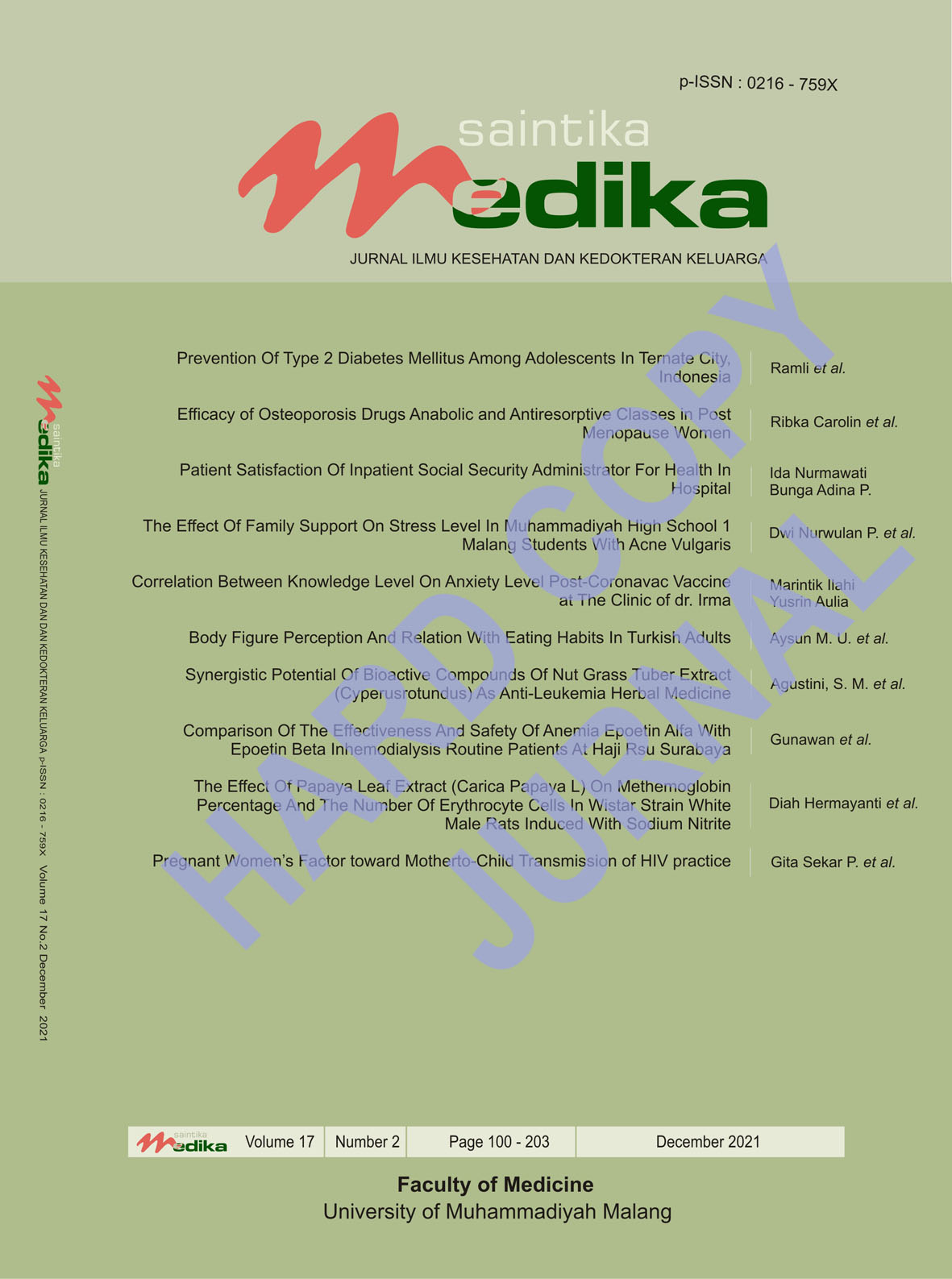The Effect Of Papaya Leaf Extract (Carica Papaya L) On Methemoglobin Percentage And The Number Of Erythrocyte Cells In Wistar Strain White Male Rats Induced With Sodium Nitrite
DOI:
https://doi.org/10.22219/sm.Vol17.SMUMM2.18803Abstract
Sodium nitrite is widely used nowadays, especially in the meat processing industry. In the case of an overdose, it can cause poisoning, which causes the oxidation of the iron component in the hemoglobin of erythrocytes to methemoglobin, thereby damaging cell membranes and hemolytic. Papaya leaves contain antioxidants that can inhibit the oxidation of iron components in hemoglobin. To determine the effect of papaya leaf extract on methemoglobin levels and the number of erythrocytes in white male Wistar rats strain induced with sodium nitrite. True experimental research design using post test only control group design. The object of this study was male white rats (Rattus novergicuswistar strain) induced intraperitoneally with sodium nitrite. The study was divided into a negative control group, a positive control group, a treatment group with a dose of papaya leaf extract PI (0.7 ml/200 g BW), PII (1.4 ml/200 g BW), PIII (2.8 ml/200 g BW). BB). Kruskal-Wallis test, methemoglobin levels sig. 0.001 (p<0.05). One wayannova test, erythrocyte cell count sig. 0.021 (p<0.05). Post Hoc test there was a significant difference between the negative control group and the positive control group on all variables, not different from the PII group for methemoglobin levels, not significantly different from the three treatment groups for the number of erythrocytes. Papaya leaf extract contains antioxidants that can inhibit the formation of methemoglobin, and maintain the number of erythrocytes. Papaya leaf extract can inhibit the formation of methemoglobin, maintain the number of erythrocytes in male Wistar strain rats induced with sodium nitrite.
Downloads
References
Alfaro, D. (2019) ‘What Are Sodium Nitrate and Sodium Nitrite_’. Available at: https://www.thespruceeats.com/sodium-nitrate-and-sodium-nitrite-facts-996129. BalkhrisnaSanthosi, Anjanappa, RaveeshaL.Naveen, B. K. (2014) ‘Acute methemoglobinemia with hemolytic anemia following bio-organic plant nutrient compound exposure_ Two case reports’.
Dela Cruz, M. et al. (2018) ‘Survival after severe methemoglobinemia secondary to sodium nitrate ingestion’, Toxicology Communications, pp. 21–23. doi: 10.1080/24734306.2018.1467532.
Dharmarathna, S. L. C. A. et al. (2013) ‘Does Carica papaya leaf-extract increase the platelet count? An experimental study in a murine model’, Asian Pacific Journal of Tropical Biomedicine, pp. 720–724. doi: 10.1016/S2221-1691(13)60145-8.
Foyzun, T. and Aktar, K. (2017) ‘Comparison and evaluation of total phenolic, flavanoid content and antioxidant activity of crude methanol and ethyl acetate extracts of Carica papaya Leaves’, Journal of Pharmacognosy and phytochemistry, 6(2), pp. 117–124. Available at: http://www.phytojournal.com/archives/?year=2017&vol=6&issue=2&ArticleId=1140&si=fal se.
Gluhcheva, Y. et al. (2012a) ‘Sodium nitrite-induced hematological and hemorheological changes in rats’, Series on Biomechanics, pp. 4–53. Available at: https://www.researchgate.net/publication/297730282_Sodium_nitrite- induced_hematological_and_hemorheological_changes_in_rats.
Hamidah, A., Anggereini, E. and Nurjanah, N. (2017) ‘Effect of Carica papaya Leaf Juice on Hematology of Mice (Mus musculus) with Anemia’, Biosaintifika: Journal of Biology & Biology Education, p. 417. doi: 10.15294/biosaintifika.v9i3.11427.
Joy Ugo, N., Raymond Ade, A. and Tochi Joy, A. (2019) ‘Nutrient Composition of Carica Papaya Leaves Extracts’, Journal of Food Science and Nutrition Research, 02(03), pp. 274– 282. doi: 10.26502/jfsnr.2642-11000026.
Katabami, K., Hayakawa, M. and Gando, S. (2016) ‘Case Report Severe Methemoglobinemia due to Sodium Nitrite Poisoning’, Hindawi Publishing Corporation, 2016, pp. 1–4. Available at: http://downloads.hindawi.com/journals/criem/2016/9013816.pdf.
Shihana F, Dawson AH, B. N. (2016) ‘A bedside test for methemoglobinemia’. Available at: https://www.who.int/bulletin/volumes/94/8/15-158147/en/.
Wang R, Teng CG, Zhang N, Zhang J, C. G. (2013) ‘A family cluster of nitrite poisoning, Suzhou City, Jiangsu, China, 2013 _ Wang _ Western Pacific Surveillance and Response’. Available at: https://ojs.wpro.who.int/ojs/index.php/wpsar/article/view/105/309.
Yogiraj, V. et al. (2014) ‘Carica papaya Linn: an overview.’, International Journal of Herbal Medicine, 2(5 Part A), pp. 1–8. Available at: http://www.florajournal.com/vol2issue5/jan2015/2-4-12.1.pdf.
Downloads
Published
Issue
Section
License
Copyright (c) 2021 Diah Hermayanti, Hawin Nurdiana, Jessica Alda

This work is licensed under a Creative Commons Attribution-ShareAlike 4.0 International License.
Authors who publish with this journal agree to the following terms:
- Authors retain copyright and grant the journal right of first publication with the work simultaneously licensed under a Creative Commons Attribution-ShareAlike 4.0 International License that allows others to share the work with an acknowledgment of the work's authorship and initial publication in this journal.
- Authors are able to enter into separate, additional contractual arrangements for the non-exclusive distribution of the journal's published version of the work (e.g., post it to an institutional repository or publish it in a book), with an acknowledgment of its initial publication in this journal.
- Authors are permitted and encouraged to post their work online (e.g., in institutional repositories or on their website) prior to and during the submission process, as it can lead to productive exchanges, as well as earlier and greater citation of published work (See The Effect of Open Access).

This work is licensed under a Creative Commons Attribution-ShareAlike 4.0 International License.
















